The Filipino adaptation of ‘The Little Prince’ is a classic in the making puppet play. It heals not only one’s inner child, but one’s present self as well.
“Tandaan, maraming pasaning gumagaan sa awit at sayaw.” —Prinsipe Bahaghari
There are a lot of great literary works. Few, however, are not only great but are also well loved by readers of all ages across the world. One of these few is The Little Prince.
Written by Antoine de Saint-Exupéry and first published in 1943, it has since become one of the most translated and bestselling books thanks to its enduring themes and charming illustrations that resonate with readers both young and old.
So timeless is this novella that I’ve read it at different points in my life, with every rereading always feeling like it’s the very first time. I read it first as a school requirement in sixth grade, then in high school, then a little later in life when I was already a professional, and finally just a few years ago, when I got hold of a special 70th anniversary gift set with an audio recording narrated by Viggo Mortensen. Each revisiting—be it by reading or through a different medium like a film or an audiobook—conjures a new learning, a new realization, or even just a simple reminder of a life lesson that has been forgotten.
Despite necessary additions and deviations, Prinsipe Bahaghari still largely follows the plot of and feels like The Little Prince. As in the novel, the play evokes feelings of wonder and joy
I was so excited, then, upon learning that Teatro Mulat ng Pilipinas (Mulat Theater or just Mulat) is staging a Filipino adaptation titled Prinsipe Bahaghari. Founded in 1977 by the late University of the Philippines (UP) professor emeritus Amelia Lapeña-Bonifacio, Mulat is one of the Philippines’ oldest puppet theater companies. “Mulat” is a Filipino word which means “to awaken,” an apt name for a theater group that aims to awaken children’s consciousness to the beauty and richness of Asian and Philippine cultures.
Set after the eruption of Taal Volcano, Prinsipe Bahaghari tells the story of a man (the narrator or the kwentista) and his strange encounter with an equally strange boy (Prinsipe Bahaghari) who shares stories of his adventures in different kingdoms.
The production is the directorial debut of Aina Ramolete with adaptation by Vladimeir B. Gonzales. While this is Prinsipe Bahaghari’s second commercial run, the first being last November 2023 at the Mulat Theater in Diliman, Quezon City, it debuted as Aina’s filmed thesis performance in 2021.
A wondrous, uplifting experience
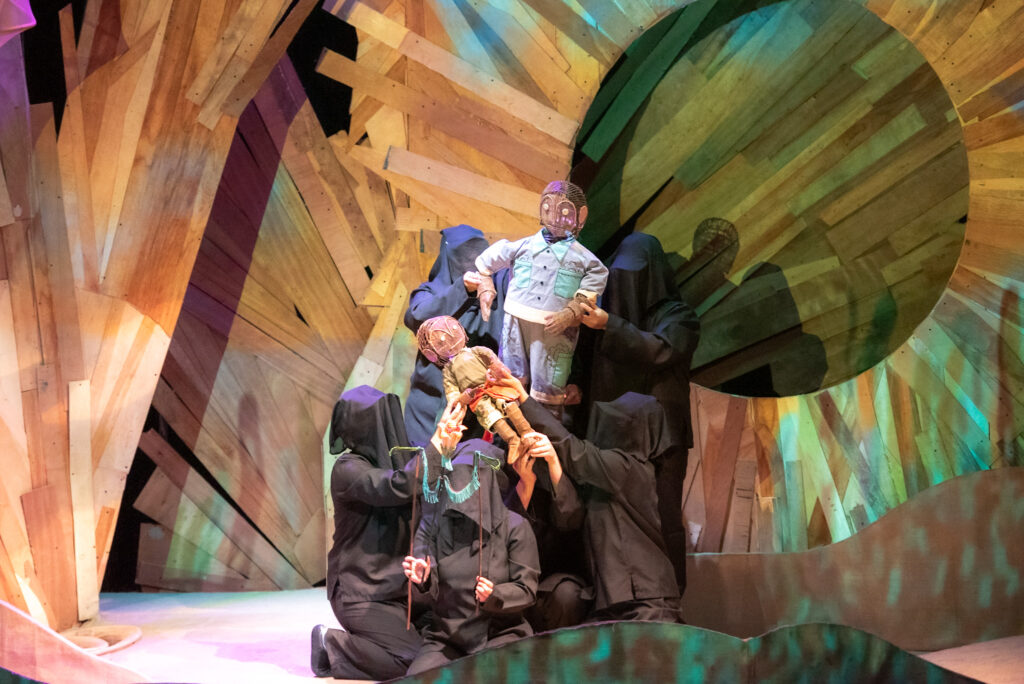
Despite necessary additions and deviations, Prinsipe Bahaghari still largely follows the plot of and feels like The Little Prince. As in the novel, the play evokes feelings of wonder and joy through its playful and vibrant illustrations that are projected on the rather simple stage.
The puppets look quite unassuming as well—with expressions unchanging—but the voices (Prinsipe Bahaghari’s spirited yet soothing voice especially), the music, and the mechanical yet charming movements breathe life into these otherwise inanimate objects.
Then there’s Vlad Gonzales’ elegant and stirring prose. Instead of sounding dated or (forcefully) contemporary in hopes of being more appealing to younger audiences, the language used is both eloquent and accessible. His evocative prose flows like poetry—much like that of Saint-Exupéry’s, such as this line: “May mga larawan at sa kulay na sa puso lamang abot-tanaw. Minsan, sila iyong sa mata’y hindi pa o hindi na masilayan.” (Yep, it’s a Filipino translation of one of the original’s most famous lines: “The most beautiful things in the world cannot be seen or touched, they are felt with the heart.”) And, perhaps, most importantly, judging from the delighted squeals during the play, even the little ones in the audience had no problem understanding the script.
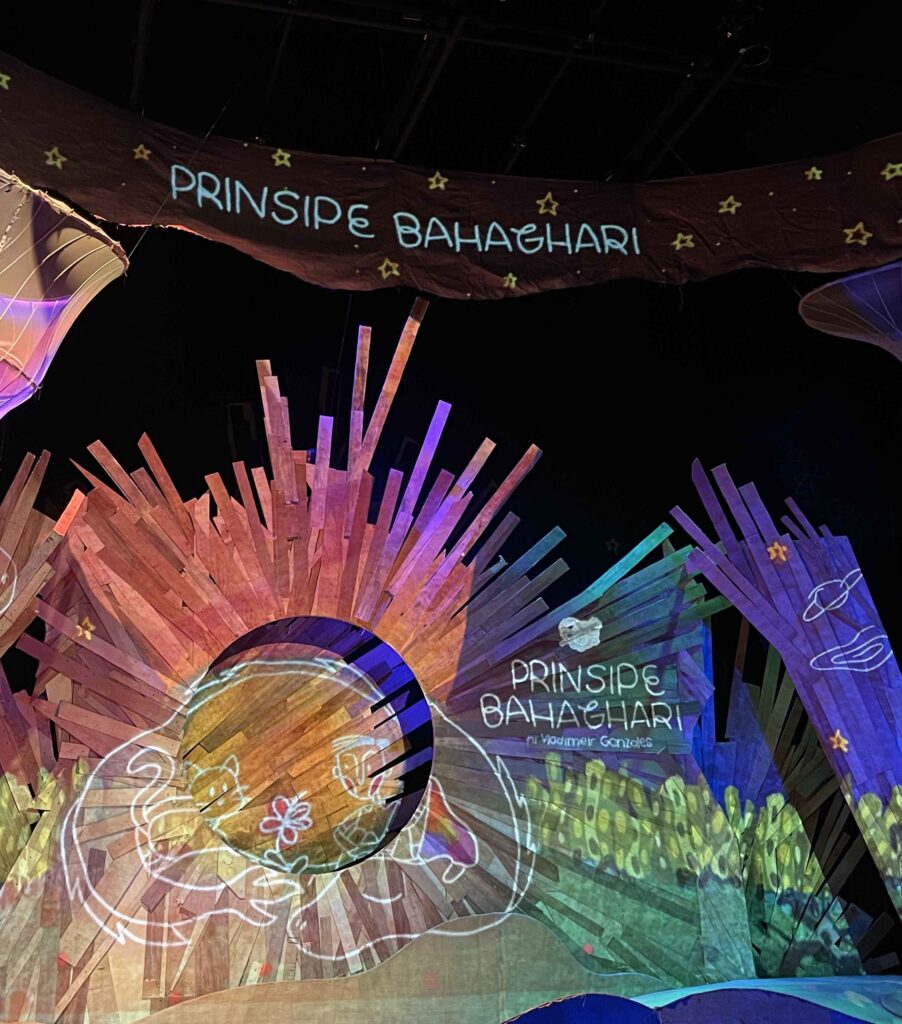
Aside from being a celebration of a well-loved classic, Prinsipe Bahaghari also celebrates Philippine culture through the use of Filipino imagery and myth, making the production very much Filipino despite the French roots of its source material. Instead of the Little Prince’s beloved rose, for instance, Prinsipe Bahaghari has his dear gumamela, whom he describes as, “Ang kaibigang maraming katulad pero nag-iisa, dahil sa itinanim na mga danas, dahil sa ating namukadkad na pagsinta.”
Instead of a fox, our titular character encounters a pusakal or pusang kalye, who helps him realize three important lessons: only the heart can see correctly; distance can help us appreciate our loved ones more; and love entails responsibility.
Even the set, the set pieces, and the puppets pay homage to our culture. All materials used in the production have been locally sourced and are sustainable, with the puppets made from rattan and the set made using jute sack and native wood.
The sound design and original music—at times whimsical and at others somber but always affecting—by Arvy Dimaculangan and Jep Gabon made use of Filipino folk instruments.
These said, Prinsipe Bahaghari is an unexpectedly delightful gem, which I daresay, is bound to be as enduring as the material from which it took inspiration. I won’t be surprised if it becomes a seminal work in the realm of Philippine puppetry.
From Diliman to the rest of Metro Manila…and beyond
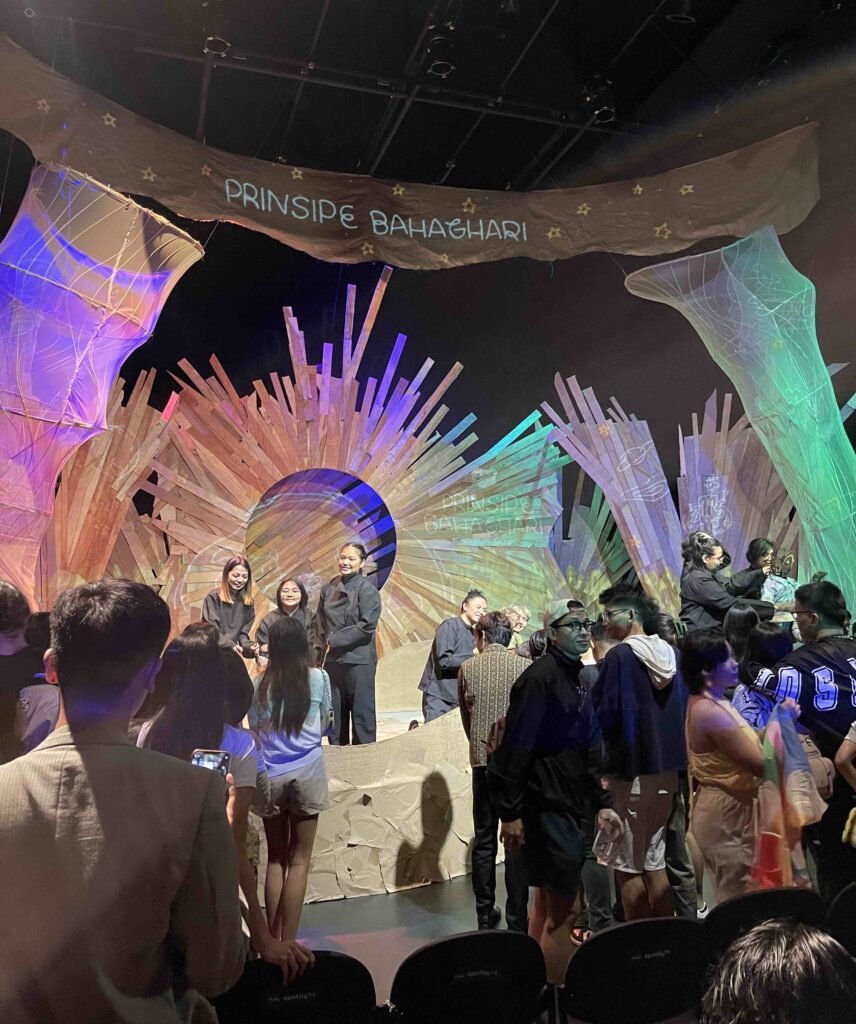
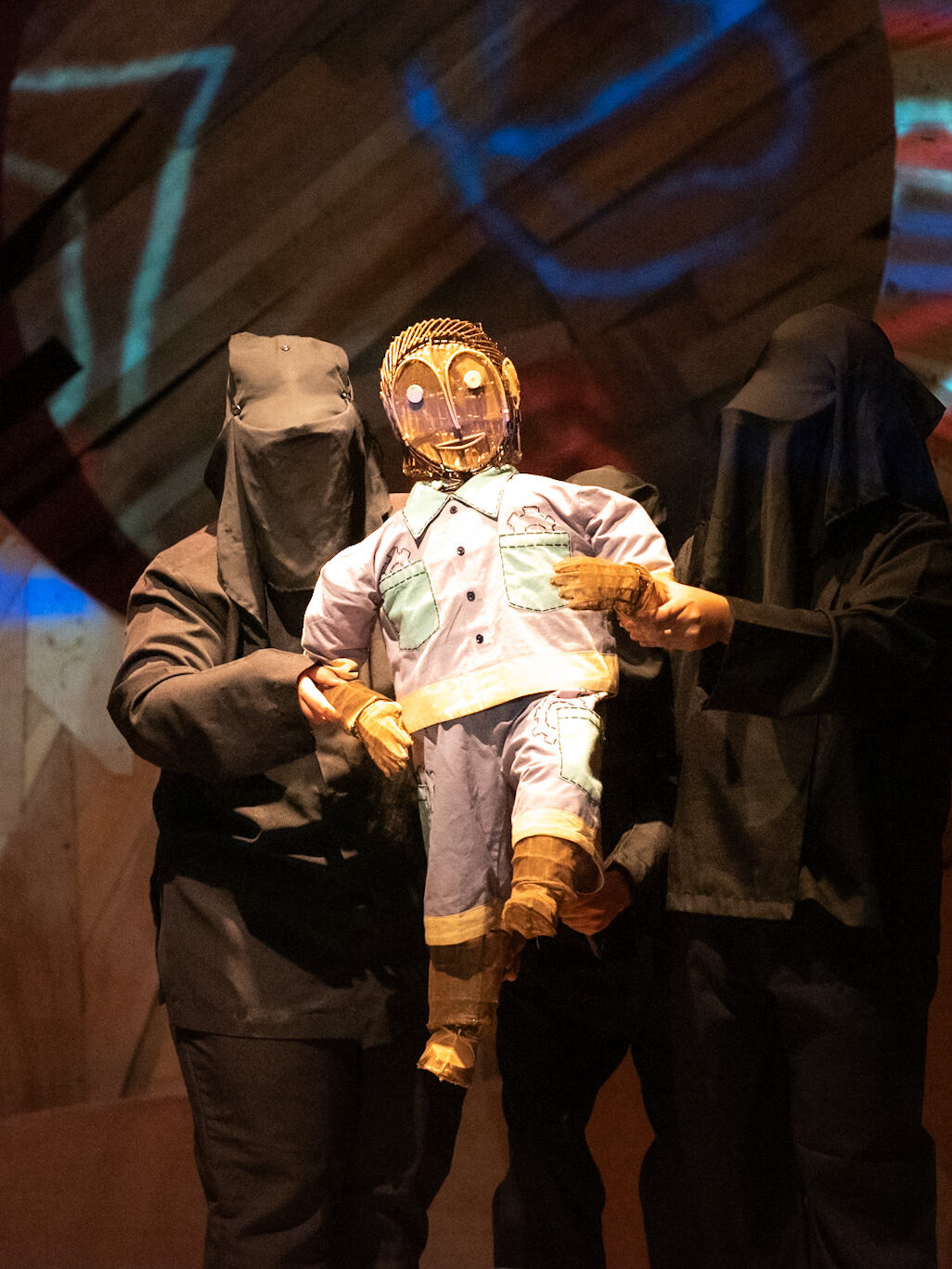
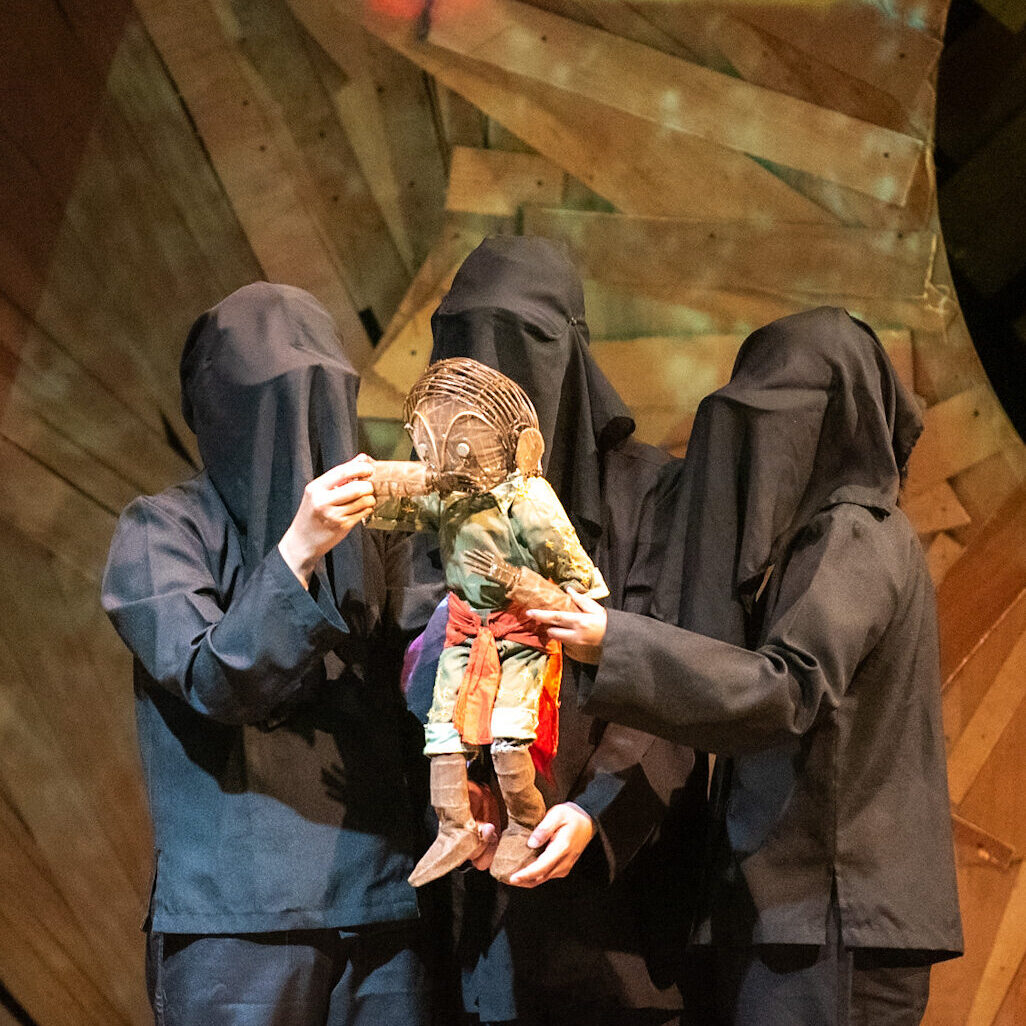
In an interview with The Post, the 25-year-old Aina shares how Prinsipe Bahaghari is actually her undergraduate thesis. The BA Art Studies graduate from the University of the Philippines Diliman admits that it was only when she was in college when she first read The Little Prince.
“When I read it as requirement in the children’s literature class of Prof. (Lalaine Yanilla) Aquino, I had so many ruminations and thoughts. I promised myself that if ever magkaka-prod ako yun ang una kong gagawin.”
“After a year or two, thesis era ko na. Thesis is usually more on research, theories but I wanted to mount a production because my minor was theater,” Aina recounts. “That’s where I started to apply art theories tapos nilapitan ko na si Sir Vlad kung pwede ba siya ang mag-adapt. Nakita ko na ‘yung past works niya with Dulaang Lab, magaling po talaga siya magsulat.”
Aina clarifies that Prinsipe Bahaghari is an adaptation and not a translation, meaning that the playwright has the creative freedom without straying too far from the essence of the text. Adaptation also involves a broader transformation of content to suit different mediums, audiences, or cultural contexts. “In this adaptation, ini-contextualize siya sa Philippine setting,” says Aina.
Translation, meanwhile, prioritizes linguistic fidelity and maintaining the original text’s meaning.
Mounting a production could be daunting, one that could test one’s composure, more so if the material is an adaptation of a beloved classic. Aina felt no such fear though, having complete trust in her team and in the material. She only felt the nerves last year during the first commercial staging of Prinsipe Bahaghari.
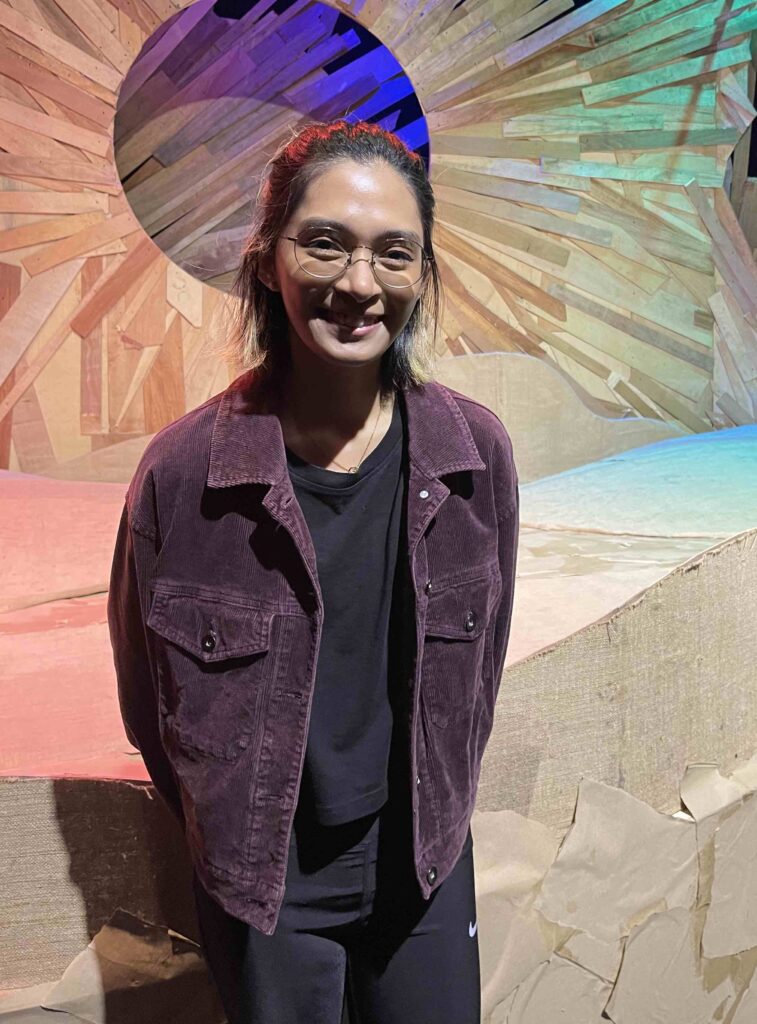
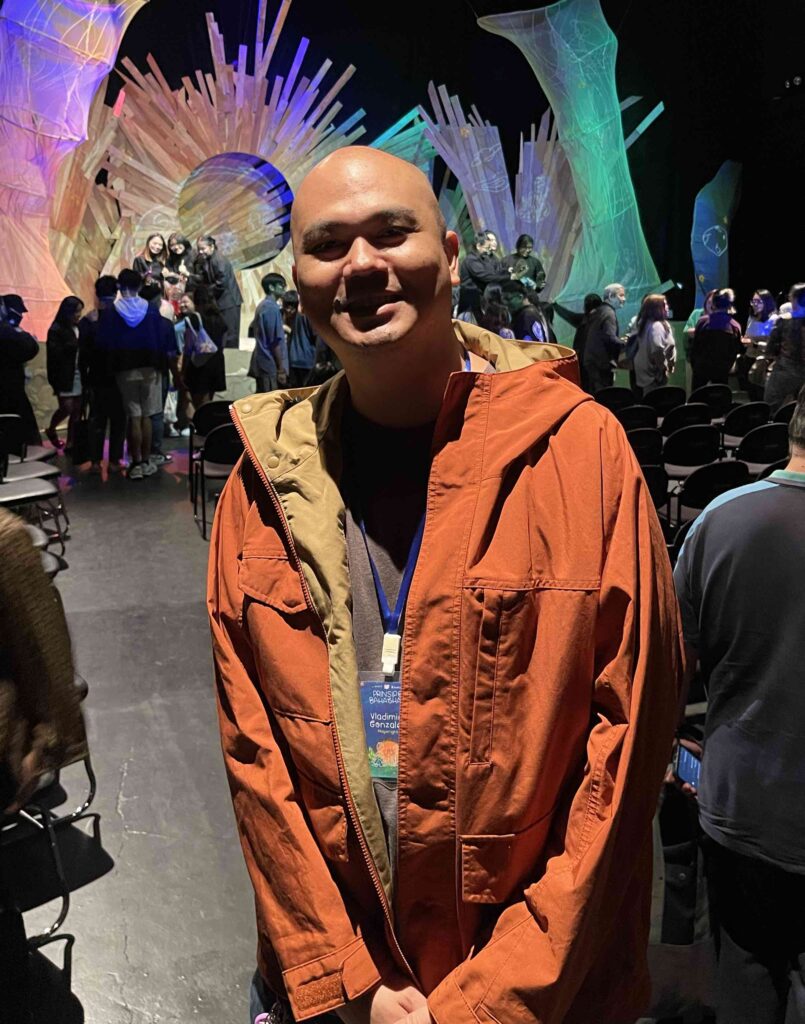
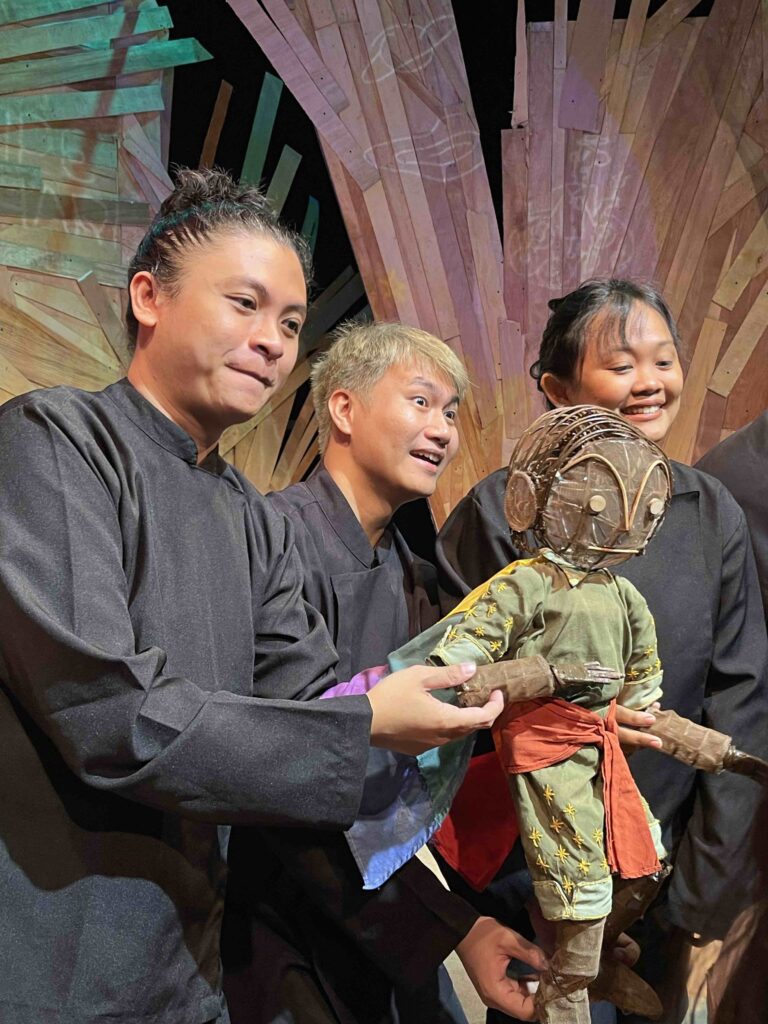

“When we started, I was full of excitement and drive, energy and passion. I poured myself and everything I had into it,” she shares. “Magaling din kasi ‘yung team ko, so hindi ako natakot na i-present siya sa ibang tao. Okay Little Prince, pero naniniwala ako sa work at sa mga tao na kasama ko, sa full capability nila, ginawa nila yung best nila, so heto po ‘yung best namin talaga.”
She adds quite emphatically: “Bakit ako matatakot na ipakita ito sa iba na heto ‘yung best namin?”
The entire process took a total of four years of painstaking labor—and love. From the confines of UP Diliman and the Mulat Theater to a bigger venue in Makati that’s more accessible to the public, Aina could only be thankful to see her work being appreciated by more people, both young and the once young.
“Never ko po na-imagine na mailalabas ko siya pero grateful po ako sa team. Si Sir Ohm (David) ang naglapit sa Power Mac (Center Spotlight) na this deserves a bigger audience,” she shares. “I hope, na dahil nailalabas na namin, na more people get to see that this is Philippine puppetry.”
Aside from Metro Manila, Prinsipe Bahaghari will also go on an outreach run in Palawan on Feb. 23, as part of the outreach program of the Cultural Center of the Philippines.
Aina comes from a family of theater practitioners and puppeteers. She mentions how it has always been her lola Amel (Amelia) and mom Amihan’s goal—eventually becoming her personal goal as well–to promote Philippine puppetry. “Very vibrant kasi ang puppetry sa ibang bansa. Sayang kasi (dito) nakikita lang sila usually as props or set pieces. Kaya ang full focus ko (para sa Prinsipe Bahaghari) wala talagang actors just puppets, para lang makita nila (audience) na ito ‘yung capabilities ng puppets and they could perform a whole show na sila-sila lang,” she explains.
Aina shares that she’s preparing for her MFA in Puppet Arts at the University of Connecticut, USA, this year, but admits she has ideas and projects in mind. She has also talked to Vlad about possible future collaborations.
Through the MFA program, Aina says she hopes to “formalize” her knowledge in puppetry, sharing how her family has been largely self-taught and experimental when it comes to the said art form.
With Prinsipe Bahaghari, Aina says she has learned many things from the production, one of the most indelible is how, in theater, as in life, everything must go through a process. “Hindi siya overnight lang nabubuo,” quips Aina. “Mahalaga na alam mo ‘yung gusto mo. Mahalaga na alam din ng mga kasama mo ang gusto nila for the production. Mahalaga na ‘yung napipili mong kasama ay may same energy as you for the production—na willing sila makipag-communicate. Willing sila magbigay ng time nila, talent nila. It takes time, effort, and patience.”
Healing one’s inner child
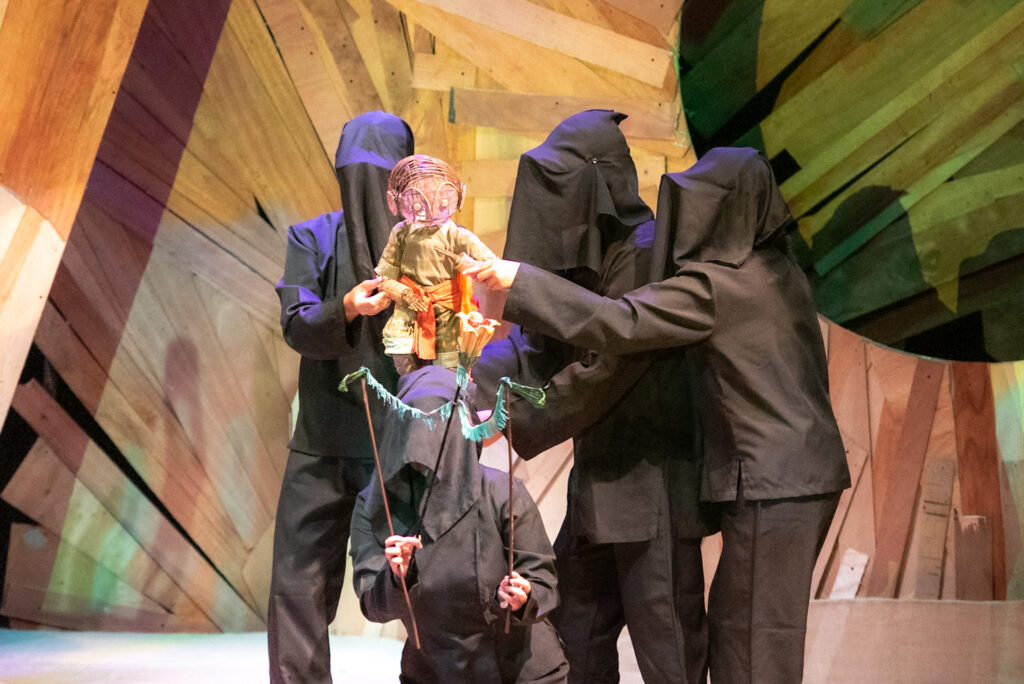


In a separate interview, Prinsipe Bahaghari’s playwright, Vladimeir “Vlad” Gonzales,” talks about his collaboration with Aina and how the play is intended to “heal one’s inner child.”
“Dati ang objective niya (Aina) is ‘yung tungkol sa mental health at saka digital technology. Nag-negotiate ako, kasi ako, ang baon ko naman sana eh ang ma-feature ‘yung legacy ng Mulat na Filipino culture, Filipino myths,” Vlad shares. “Nag-try kami paghaluin ‘yun, pero kay Aina mostly ‘yung ideas. Ako naman, in-assess ko kung paano maitatawid ‘yung idea na happy ako at happy rin ‘yung Mulat.”
Even as a seasoned playwright, Vlad still finds it challenging to adapt The Little Prince into a Filipino puppet play. “Okay naman ito kasi classic. Ang iniisip ko, paano magiging respectful pero syempre ano rin ‘yung medyo makakagulat din sa inyo kaya may ilang bago. I-balance ba ‘yung gusto ng mga ka-collab ko,” he says.
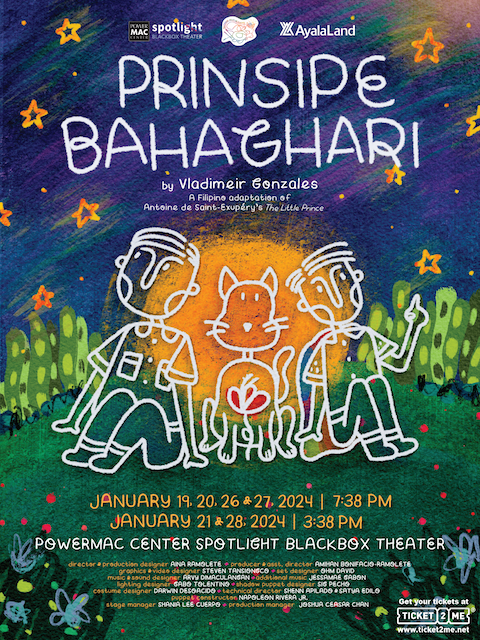


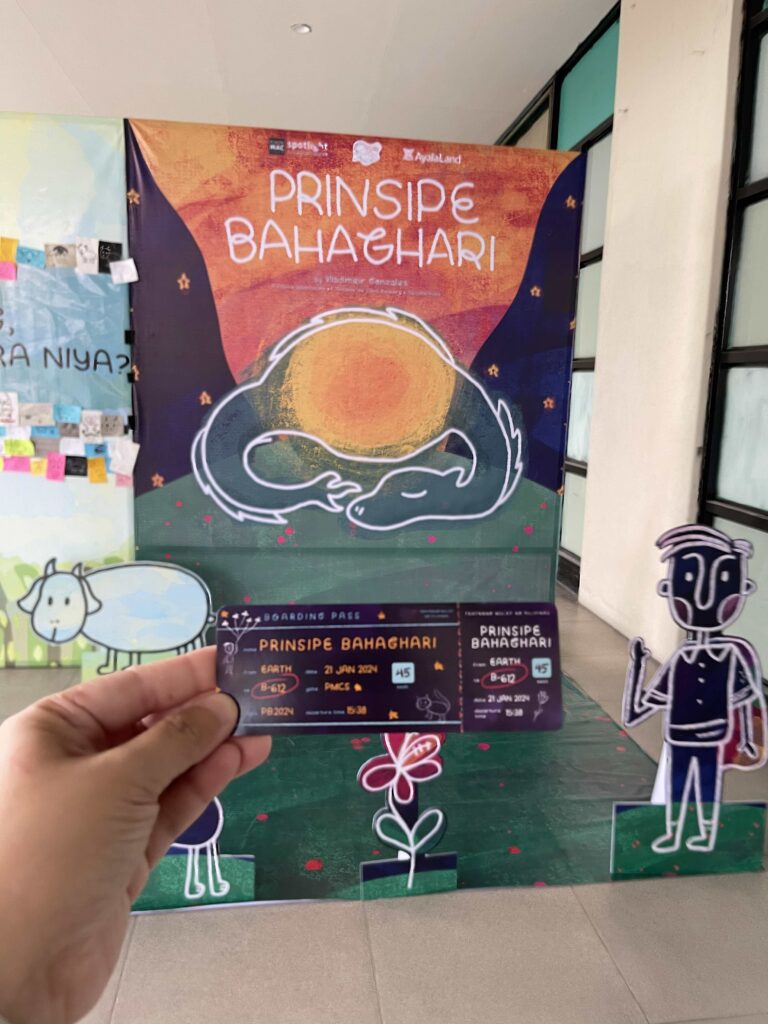


He shares that he finds it easy working with Aina, the production team, and the rest of Mulat. He explains: “May changes, pero ano sila eh, respectful. Halimbawa, not so much into digital culture pero try natin na ‘yung vibe niya eh feel pa rin ‘yung The Little Prince na ‘di masyado ma-tech. Nagne-negotiate lang sila na, ‘Sir, pwede ba itong idagdag kasi kailangan sa istorya.’”
“Gusto namin maitawid na meron siyang vibe na may kasama kang anak, pero ikaw din na parent ay may mapupulot. ‘Yun din naman yung plano—‘Yung healing the inner child,” adds Vlad, who is also professor of creative writing and literature at UP Diliman’s Departamento ng Filipino at Panitikan ng Pilipinas.
Much like Aina, Vlad, despite his many years in the theater industry, also has realizations from the entire process of mounting a production. “(Prinsipe Bahaghari is a) reiteration na hindi talaga singular project ang theater. Happy work siya kasi laging may bagong inputs from the collaborators. Happy ako sa isang klase ng art na ‘yung may vision ‘yung mga tao tapos nakakatulong ka sa pagpapatingkad (ng talento)—’yung invisible ka for a while para ma-feature naman ‘yung talents ng iba.”
He adds: “Kaya ako nagsta-stay. Daming beses ko nang sinasabi na ayoko, pero may magic kasi siya eh. Lagi kang may nadi-discover na bago dahil laging kang may maraming kasama, may community.”
Vlad never thought he would be a writer for children but knowing how Prinsipe Bahaghari has brought so much joy to its younger audience makes him happy.
Asked what he thinks about the future of Philippine puppetry, Vlad says he can’t be too sure. “I guess in a way, kasi ito ‘yung parang unang commercial project. Kung in the future naramdaman namin na na-reinvigorate ang puppetry, happy ako na nagkaroon (ako) ng ambag.”
He ends by saying with a big warm smile: “Happy journey lang ito kung saan nila ako dalhin join lang ako sa kanila.”
Prinsipe Bahaghari’s closing weekend will see shows on Jan. 26 and 27 at 7:38 pm, and Jan. 28 at 3:38 pm, at the Power Mac Center Spotlight Blackbox Theater, Makati. For more information, follow Teatrong Mulat ng Pilipinas on Facebook and Instagram.




